You may or may not be aware that there are federal and state laws that govern truck size and weight standards. Many of these laws apply to RVs as well. Maximum gross vehicle weights and axle loads on the interstate system are controlled by federal law. Federal limits allow for 20,000 pounds on a single axle. For a tandem axle group, the limit is 34,000 pounds. And all of this brings us to our topic, the tag axle RV.
Let’s check it out!
- 1) What Is a Tag Axle RV?
- 2) What Are the Benefits of a Tag Axle?
- 3) What Are the Disadvantages of a Tag Axle?
- 4) Is a Tag Axle the Same as a Dead Axle?
- 5) Why Would You Need One On a Motorhome?
- 6) How Much Weight Can an RV Tag Axle Hold?
- 7) What is An Example of a Tag Axle Motorhome?
- 8) What Do You Think?
What Is a Tag Axle RV?
A tag axle RV is a motorhome that has a third axle located behind the rearmost axle. It gets its name from the fact that it “tags” along behind the drive axle. It’s a non-drive axle that typically has a single tire on each side.
Large motorhomes are heavy, and each axle can only carry so much weight. The longer, larger, and heavier an RV, the more likely it is to require a tag axle to carry that additional weight.
The primary purpose of a tag axle is to provide increased weight-carrying capacity for larger/heavier motorhomes. A tag axle increases the support of the chassis at the rear of the RV to allow for greater weight carrying capacity, and results in a more stable ride.
A tag axle is most frequently used on RVs that are 40 feet long or longer. Other than tag axle rigs typically being longer, the presence of a tag axle itself doesn’t demand anything different from a driving standpoint.
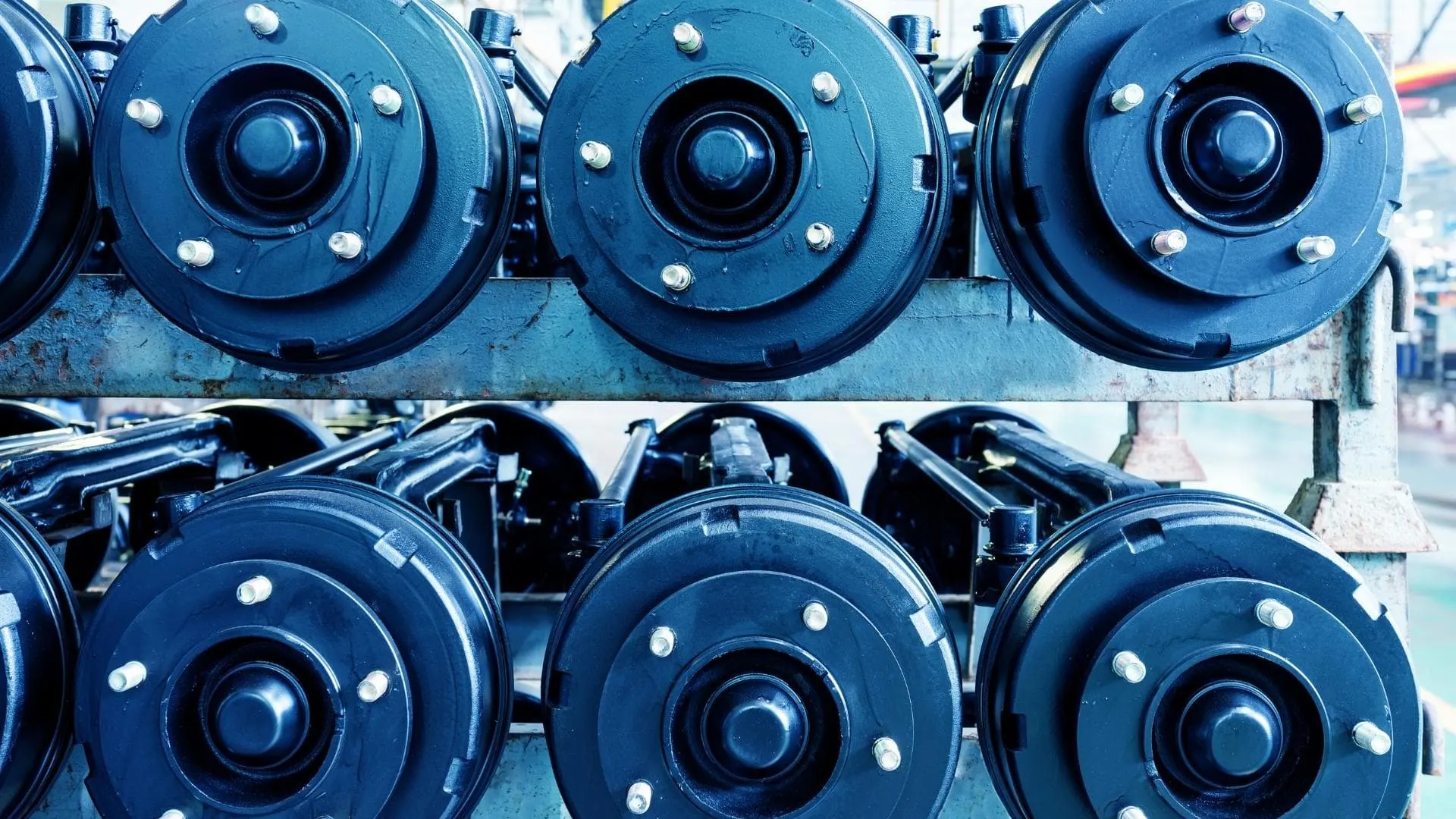
A tag axle RV can carry thousands of pounds of additional gear, thanks to that additional axle. The tag axle also contributes to greater stability on the highway or in windy conditions.
What Are the Benefits of a Tag Axle?
- Allows an RV to weigh more without exceeding the carrying capacity of a single rear axle. This means that the RV itself can not only be larger, but it can also carry thousands of extra pounds of gear and/or amenities. This could be especially important for a toy hauler, for example, some of which carry ATVs or even an additional vehicle, or the addition of heavier features, such as solid wood cabinetry and tile floors.
- Allows for more stability, especially at highway speeds, or in windy conditions. (For related information about driving stability, please see our post on trailer sway control.)
- Provides a smoother ride due to the additional support and shock absorption
- Offers more living space due to the additional length of the rig
- Increased contact with the road surface provided by the extra tires
- Better stopping power from adding an additional set of brakes. Modern tag axles are equipped with brakes, so while the tag axle isn’t connected to the drivetrain, the added braking power can increase traction and reduce stopping distance.
- Offers increased support at the rear of the chassis. The increased support provided to the rear of the chassis by a tag axle is important in that it adds that extra set of shock absorbers and airbags (on diesel rigs). But it also spreads the load across a larger area of the chassis.
And since the tag axle is usually located further back than a single axle would be, there’s less rear overhang. That means the rear of the chassis is less likely to hit the ground when driving on uneven terrain or up steep inclines. And you’re less likely to hit it when making sharp turns.
For more detail about rear overhang, check this video from the RVgeeks Driving School:
What Are the Disadvantages of a Tag Axle?
- Harder to fit in some RV campgrounds because the rig is too long, and the shorter overhang means you can’t “stick the tail out” over the back of a shorter site/pad. (For more information, see our posts on big rig RVs and big rig RV parks.)
- Extra cost on many toll roads, which often charge by the axle
- Higher cost of tires (typically 8 -vs- 6)
- Higher cost of shock absorbers (3 axles -vs- 2)
- Lower fuel mileage / higher fuel costs, due to increased weight
- Higher initial purchase price
- Potential loss of basement storage, especially on shorter models (40′ RVs with a tag axle typically lose an entire basement storage compartment when compared to equivalent non-tag axle 40′ models)
- Increased tire wear due to sideways “scrubbing” effect while turning
One note about that last bullet: Some higher-end rigs are equipped with a “lifting” tag axle, which allows their tires to be raised off the ground during tight maneuverings, such as while backing into a campsite.
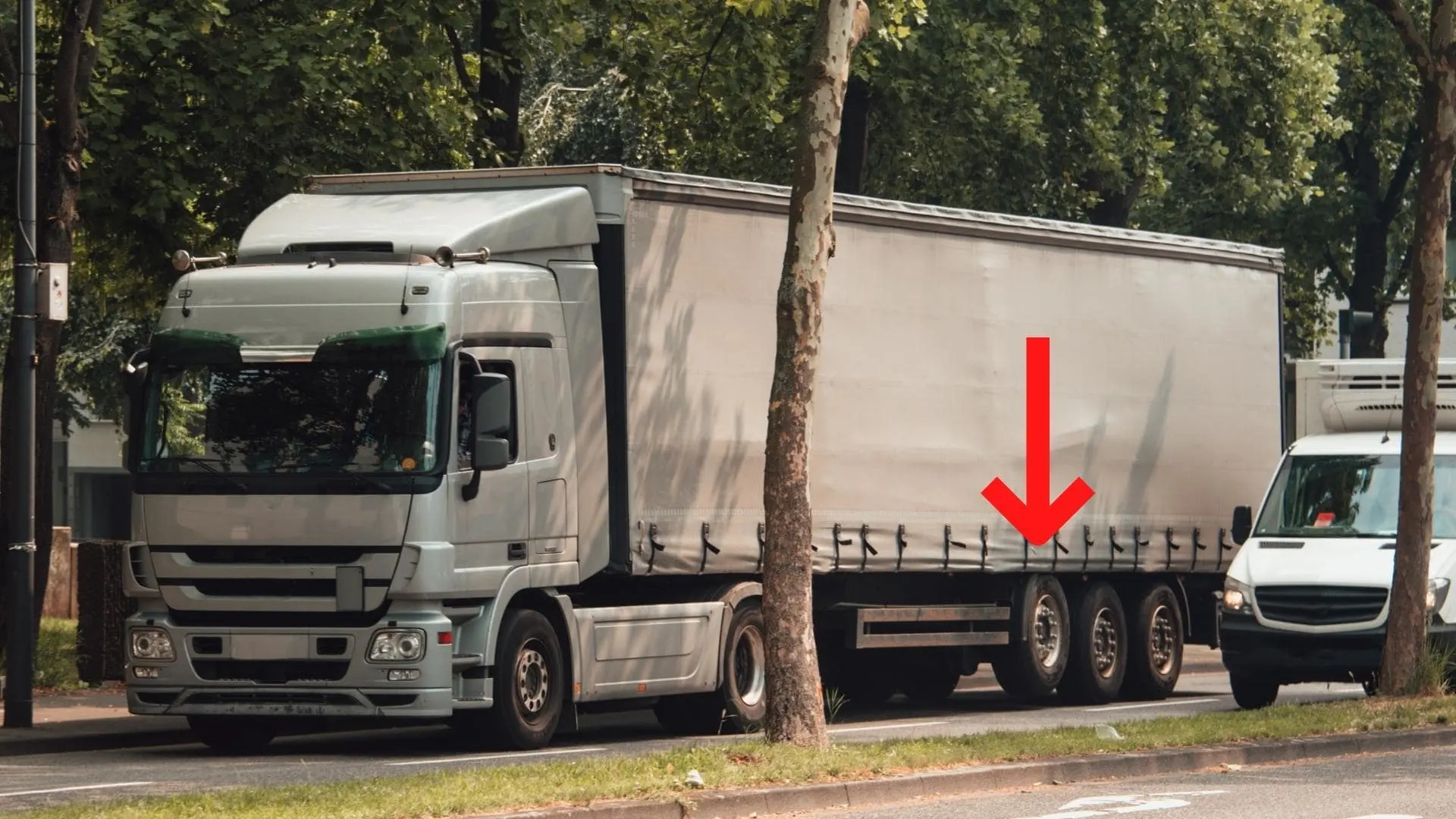
If you look carefully below the red arrow, you’ll notice a lifted axle on this freight truck. An RV with a liftable tag axle benefits from reducing the scrub of the tag axle tires when making tight turns.
Other rigs simply dump the tag axle airbags during reversing to reduce the scrubbing effect. Neither of those will help save tire rubber when driving forward around a tight turn with the tag axle on the ground. That’s why tag axle tires wear out faster.
The biggest negatives of a tag axle RV involve the additional costs associated with it. As you conduct your routine RV maintenance tasks, you’ll have another axle to examine. The bearings on all axles will require annual lubrication, and the brakes inspected and replaced. Doing this maintenance work yourself certainly lowers the cost substantially, but requires additional time due to the extra axle.
Remember, too, that with a tag axle you’ve got two additional tires. So, when it comes time to replace your rubber, you’ll be replacing more of it, typically 8 tires rather than 6. And since the biggest rigs are the ones most likely to be equipped with a tag axle, they’re also the ones with the largest, and therefore most expensive, tires.
All this really magnifies the cost. When it comes time to replace our tires, they can run as much as $1,000 each. It doesn’t take a calculator to figure out the difference between a $6,000 bill, and an $8,000 one. Of course, we save a lot by using our FMCA tire discount!
Is a Tag Axle the Same as a Dead Axle?
Usually, a tag axle is considered a dead axle because it simply provides more stability for the extra weight being carried, and doesn’t help to steer or drive the RV in any way. But this isn’t always true. It’s increasingly common on higher-end RVs to find a “steerable” tag axle.
Usually mechanically driven, a steerable tag axle follows the RV as it’s turning (up to about 5-10 degrees), helping to reduce tire scrubbing (and therefore wear) on the tag axle tires, while also helping to slightly improve the overall turning radius of the RV.
Why Would You Need One On a Motorhome?
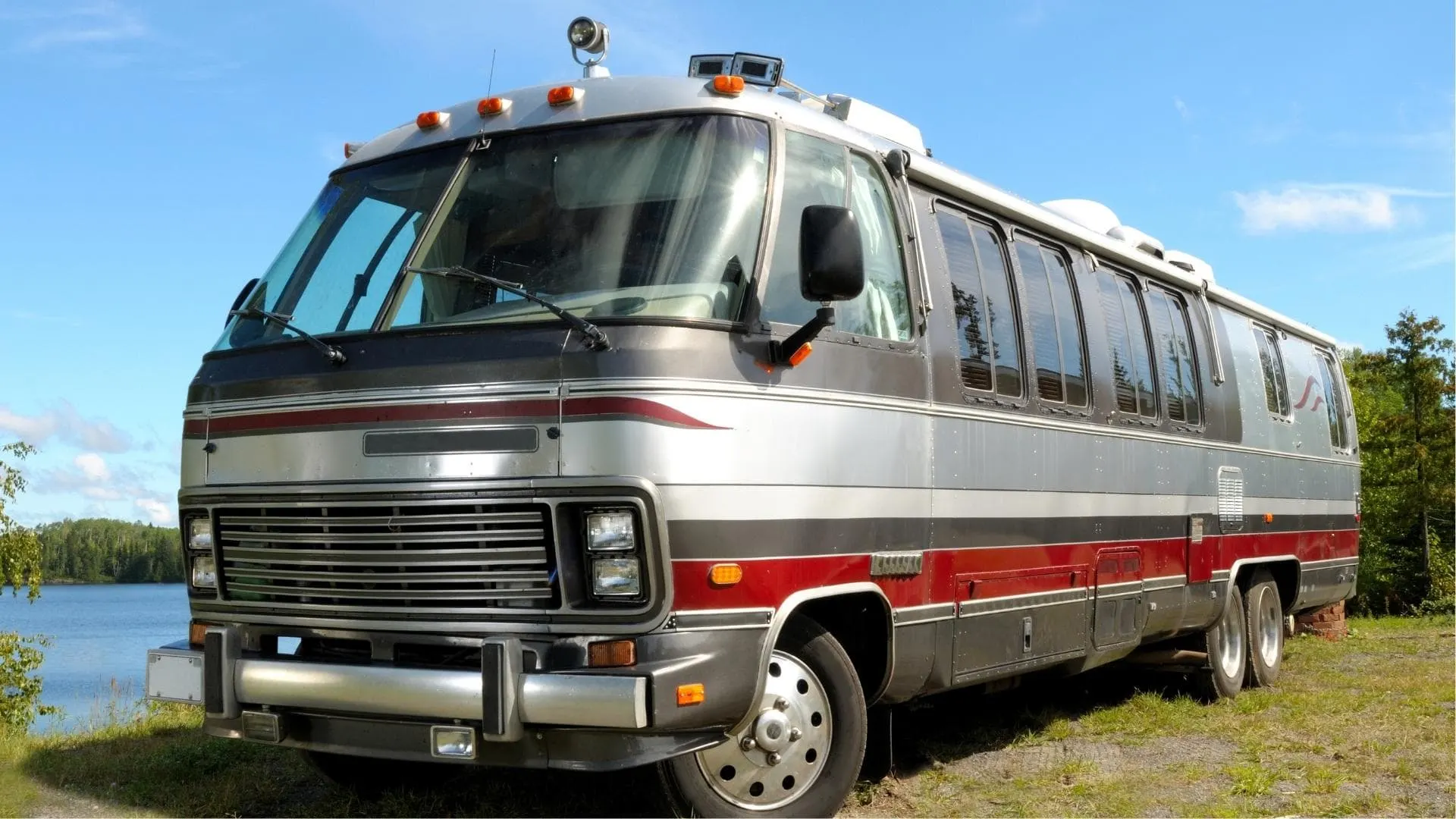
Note the tag axle at the rear of this vintage motorhome. The additional axle allows for it to carry more weight, accommodating things like heavy furniture and appliances.
Perhaps the most common reason for a tag axle on an RV is the traveler’s desire for additional amenities that manufacturers seek to provide based on customer demand. Adding more “stuff” such as washer & dryer, dishwasher, porcelain tile floors, or hardwood cabinetry all add extra weight.
At some point, all that equipment, and a larger/longer rig to house it all, is too much weight for a single axle. The tag axle takes the pressure off of the drive axle by sharing the load.
The assistance provided by the additional axle also allows travelers to carry more provisions and gear. Depending on the design and floorplan of a particular rig, that can include heavy items like ATVs, bicycles, kayaks, motorcycles, or even a car.
In addition to all of this, some travelers appreciate the added stability and balance provided while reducing rear overhang, and most would probably agree that the extra shocks & airbags provide a smoother ride.
And finally, most RVers would be happy to reduce concerns about overloading the rig. Several thousand pounds of extra carrying capacity can allow for a lot of stuff!
In fact, that’s why manufacturers likely appreciate that extra axle, particularly for very high-end rigs with luxury features. They don’t have to skim on amenities because weight isn’t usually as much of an issue as it is with a single axle.
How Much Weight Can an RV Tag Axle Hold?
The answer to this question depends on the rating. Not all tag axles are created equal. But most tag axles on RVs can handle between 10,000 and 20,000 pounds, depending on the size of the axle. So, the size of the tag axle will determine the amount of weight the axle can support.
This question mostly comes into play when determining the total overall amount of cargo-carrying capacity your rig can handle, and when figuring out the correct pressures for your tires. We’ll be addressing that specific topic in an upcoming post, so stay tuned!
What is An Example of a Tag Axle Motorhome?
Newmar’s Dutch Star 40’ and 43’ motorhomes are examples of tag axle motorhomes.
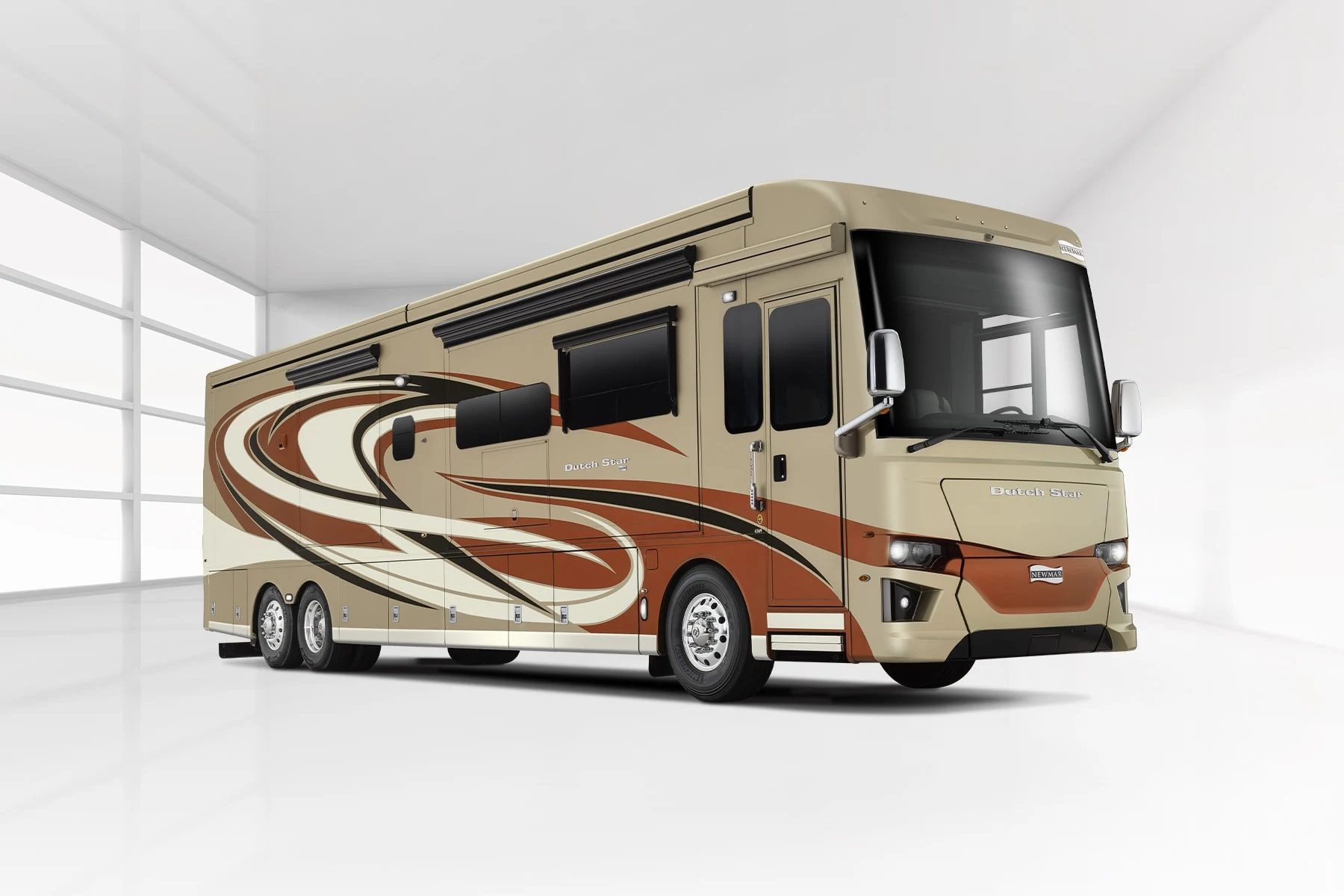
This is the 2022 Newmar Dutch Star. Note the tag axle at the rear of this very large motorhome. (Photo credit: Newmar)
Built on the Spartan K2 450 chassis, these are Class A RVs with Allison 3000MH transmissions and Cummins engines producing 450 hp @ 2,100 rpm. The fuel tanks of the Dutch Star tag axle RVs hold 100 gallons (40’) or 150 gallons (43’) with dual side fills and 15-gallon DEF tanks.
In typical Newmar fashion, the Dutch Star offers several configurations of luxurious rigs with well-appointed interiors. (Some floor plans include two full baths and cathedral ceilings.)
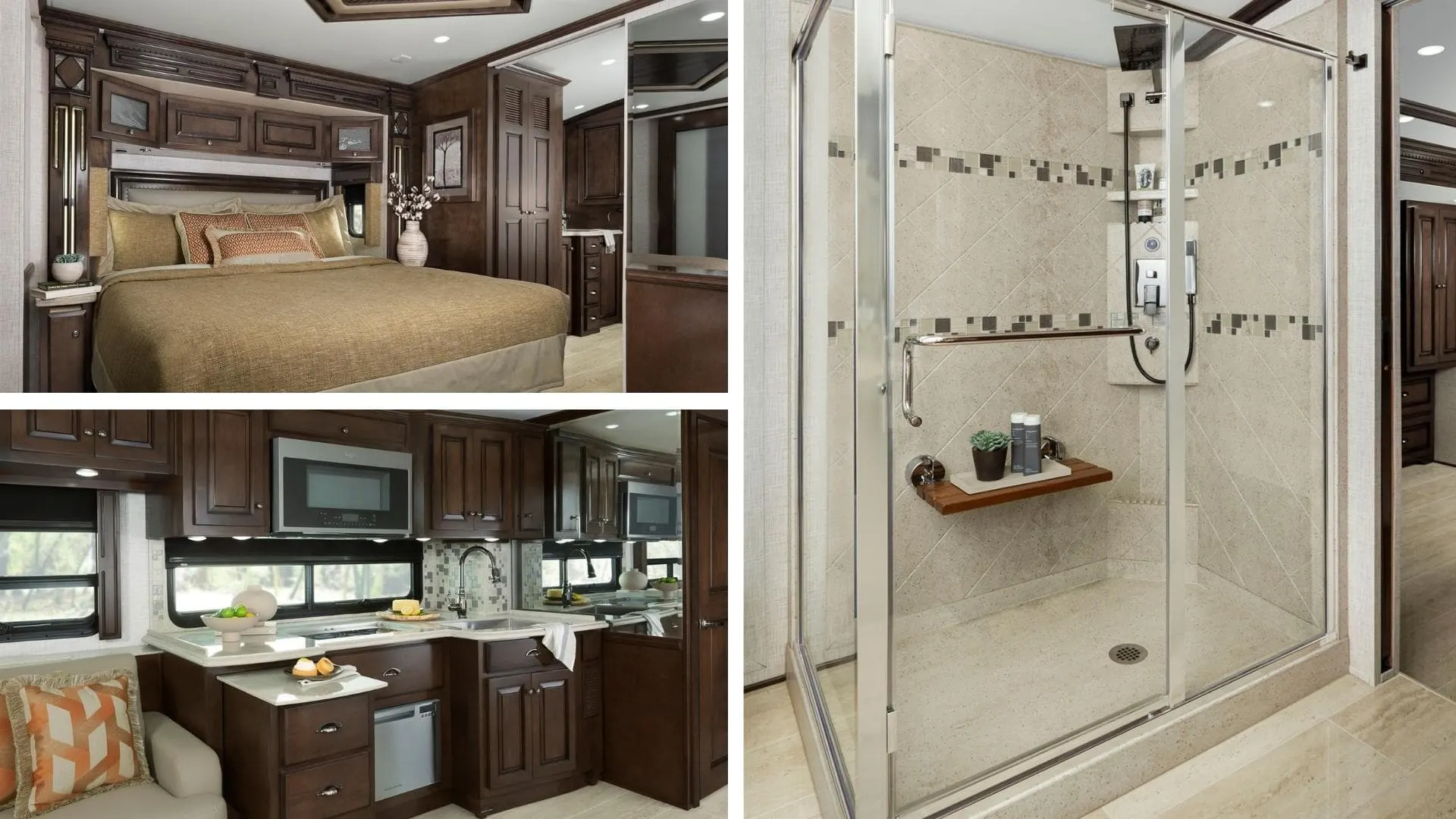
These photos show the well-appointed interior of a 2022 Newmar Dutch Star. Solid wood cabinetry, floor tiles, solid surface countertops, and full shower tile like these increase the weight of the rig significantly, thus require the use of a tag axle. (Photo credit: Newmar)
The 40-foot iteration of the Dutch Star has a 252-inch wheelbase and a 48-inch tag, and the 43-foot version has a 288-inch wheelbase with a 48-inch tag. Both have a towing capacity of 15,000 pounds.
Both have independent front air suspensions (the 40’ with a 17,000 lb capacity and the 43’ with a 20,000 lb capacity), with non-torque reactive parallelogram air suspensions in the rear (20,000 lb capacity).
Both the 40’ and the 43’ Dutch Star models have a tag axle with parallelogram air suspension and integrated passive steering with a 12,000 lb capacity.
For more information and history on Newmar, see our post about Newmar Motorhomes.
We toured Newmar’s first Super C motorhome, the Super Star, back in 2019. We were impressed but, being Newmar motorhome owners ourselves, not at all surprised by the high quality and attention to fine detail.
Here’s the video of our Super Star tour:
What Do You Think?
Have you owned a tag axle motorhome? We’d love to hear your thoughts on the pros and cons. Drop us a comment below!
Geek Out with Us Every Week
Join our newsletter to learn about all things RV-related. Every week we offer free tips, tricks, product reviews, and more to our online community of RVers. So, whether this is your first time on the road or you’re a seasoned expert, we’d love for you to geek out with us!


Bruce Gruenbaum
Wednesday 13th of March 2024
We bought our 2017 Newmar Ventana 4002 in April 2022. It has a passive steer tag axle. The axle weight limits are:
Front: 14,000lbs Drive: 20,000lbs Tag: 10,000lbs GVWR is 44,000lbs and UVW is 34,850lbs. CCC: 9,150lbs
We carry a motorcycle (930lbs) on a lift (450lbs) on the back of the rig. Fully loaded, with the motorcycle, full water, black, grey and fuel tanks, the rig weighs 39,850lbs, so we are still 4,150lbs under weight fully loaded!
The passive steer tag axle means this rig turns on a dime. I am constantly amazed at how incredibly easy it is to drive, even fully loaded towing a Jeep Cherokee Trailhawk (4500lbs).
We're glampers and consider our rig ("Coco") an apartment on wheels. She's all electric, so we drive with the generator running a lot of the time (haven't done solar yet), and even with that fully loaded, we generally get between 7.5 and 8.4 mpg out of the 400hp Cummins with Allison transmission on a Freightliner chassis.
There are two gotchas that we did not expect:
1) GVWR is not really the limiter for us. When she's fully loaded with the bike on the back, we have to watch the rear axle weight limit because it flirts with 30,000lbs. The motorcycle extends 5ft to the rig length and acts as a pretty strong counter weight. Carrying more weight up front is actually harder than I imagined.
2) Tailswing is still as much of a factor as it is with a single rear axle, and actually with the bike on the back it's much more exaggerated. We've had a couple of near misses with the Jeep where a turn to the driver's side nearly resulted in the front of the Jeep hitting a wall on the passenger side.
We had to replace tires as soon as we got the rig in 2022 (negotiated into the sale price) and at the time, the 8 305/70/22.5's cost us a total of $9,180 to install with significant discount (I think it was 25%) from Michelin.
All that said, she is an amazing rig and we love her to bits. We can't plan on camping in most state or national parks, but that's not a big deal for us. We generally plan most of our travel well in advance anyway.
Ed Fogle
Wednesday 13th of March 2024
Saying the tag axle reduces overhang implies the main rear axle remains in a position it would be if the rig didn’t have a tag axle. If that is so why would basement storage space be lost. Perhaps the main rear axle moves forward but not as much as the tag axle wheel diameter. I’m confused.
Bruce Gruenbaum
Wednesday 13th of March 2024
@TheRVgeeks, I can confirm this is pretty much spot on. A friend of ours has a Newmar Canyon Star with exactly the same layout as our Ventana. Their drive axle is a half wheel length back from ours and they have more storage both in front of and behind the drive axle. We have no storage behind our tag axle on the passenger side.
TheRVgeeks
Wednesday 13th of March 2024
Hi Ed! Great point, and good question. Sorry we weren't clearer about the overhang situation. We didn't mean to imply that the drive axle stays in the same location when a tag axle is added. It generally moves forward, sometimes by a fair amount, reducing basement storage in the process. Depending on how far forward the drive wheels are moved to fit a tag axle, there's a loss of some basement storage and some rear overhang. It's a balancing act. But most of the lost length (basement storage vs rear overhang) usually goes to the overhang, since it would probably be a bit rare for the drive wheels to be moved forward as much as, or more than, about 1/2 the diameter of the tax axle. Hope this helps!
Dave Williamson
Wednesday 13th of March 2024
I would like to see an article about the how/why/when/where of “dumping” the tag axle. I have read a couple in the past but am still not really clear about it. We full-time in a 2027 Dutch Star 4369 (and love it!). I have dumped the tag axle when extricating ourselves from a soft/grassy/muddy parking spot, thinking that it puts more weight on the drive axle. Newmar (or Freightliner) labeled the 3-position toggle dump switch in a very confusing way, and’s I gather that I’m not the only one who thinks so. So, I’d love to see one of your typical extremely clarifying articles on that!
TheRVgeeks
Wednesday 13th of March 2024
Thanks so much for the topic idea, Dave! Always great to hear from a fellow Newmar owner. There are definitely weight and traction considerations to consider. We've added it to our list, and will see if we can come up with enough worthwhile info about tag axle dumping to make an article out of it.
Greg
Thursday 7th of December 2023
I just purchased, a new to me, Monaco Dynasty 42ft. The tag axle pressure regulator has got me confused. I went to a Cat scale and my drive was 4000# overweight and my steer was 500# overweight. My regulator was set at 80psi, probably too high? I lowered it to 40 psi, per forum recommendations. I also contacted Monaco and I'm waiting for tgeir reply. Your thoughts?
TheRVgeeks
Thursday 7th of December 2023
Hi Greg. Congrats on your new coach! The Dynasty is a very nice motorhome and we hope you have many wonderful years traveling in it!
We're not that familiar with the exact operation of the tag axle regulator valve Monaco uses, but have a general idea of its purpose... helping to balance the weight on the axles. Increasing the pressure on the tag should increase the amount of weight it's carrying, while also pivoting more weight onto the steering axle. Lowering the pressure would reduce the weight on the steering axle, while shifting more weight onto the rear. How it interacts with weight on the drive axle, though, is important... especially since you're heavy on your steer AND drive axles.
We found this thread on the Monaco Owner's discussion forum over on iRV2.com (https://www.irv2.com/forums/f115/tag-axle-pressure-adjustment-631031.html) that may help... the fourth response includes a quoted section from the owner's manual that goes over the procedure for how to make adjustments to the pressure and how to weigh to confirm the correction.
We don't think there's a "one-size-fits-all" pressure for that regulator, as it all depends on where the weight is being carried on your motorhome. It's possible that you'll have to move some heavy stuff in addition to properly adjusting the regulator to balance things out.
Jim
Friday 6th of January 2023
Inherited a 36' National Dolphin (F53) with Tag axle. Article references benefit of additional weight capacity. What's your thoughts re: Tag and the sway when big trucks pass me? I was thinking about a Trac bar, but wondered if it would be a waste of money since I already had the tag axle.
TheRVgeeks
Friday 6th of January 2023
Hi Jim. Good question... having a tag axle can definitely help to stabilize the ride. We have no experience with a Trac bar, but our general rule of thumb for modifications of that sort is to use them for the primary purpose of correcting a deficiency. If the ride seems solid, stable, and comfortable to you, we probably wouldn't make any change at all.